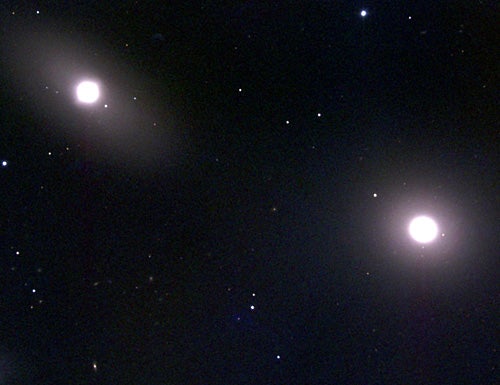Astrophysicists believe they’ve turned up evidence for dark matter halos in elliptical galaxies. The finding contradicts 2003 studies suggesting these galaxies lack such halos, and it supports the view that large amounts of matter astronomers cannot detect — dark matter, or DM — provided the gravitational clout that began galaxy formation and still surrounds them.
Not surprisingly, proponents of the leading alternative to DM, a modified theory of gravity called MOND — short for Modified Newtonian Dynamics — remain unconvinced.
Astronomers proposed dark matter decades ago to explain why clouds of gas on the outskirts of spiral galaxies rush along at essentially the same speed as gas and stars in close-in orbits. Based on observations of spiral galaxies, galaxy clusters, and gravitational lenses, most astronomers now believe dark matter pervades the universe and greatly outweighs normal matter. A galaxy’s dark-matter halo can be 20 times more massive than everything in it astronomers can see.
Until recently, observers could only guess how much dark matter elliptical galaxies contained. Unlike spiral galaxies, normal ellipticals lack disks that made it easy for astronomers to track rotation. That changed in 2003, when Michael Merrifield and Aaron Romanowsky, then at the University of Nottingham in England, managed to measure the speed of planetary nebulae — glowing gaseous shells shed by dying stars — skirting five elliptical galaxies: M105 and NGC 821, 2434, 4494, and 4697.
To their surprise, the velocities of the planetary nebulae fell off with distance from the galaxy centers, just as would be expected if elliptical galaxies contained “little if any” dark matter.
The apparent absence of dark matter challenged DM theory, but buoyed its main competitor, MOND. Proposed in 1983 by Mordehai Milgrom of the Weizmann Institute in Israel, MOND predicted that the speed of objects orbiting elliptical galaxies would decline with distance, just as seen by Romanowsky and Merrifield.
Now, to the relief of DM theorists, astrophysicist Avishai Dekel of The Hebrew University in Jerusalem thinks he’s has found the missing dark matter.
Dekel and his colleagues simulated collisions between 10 pairs of spiral galaxies wrapped in massive dark matter haloes. As expected, the three-dimensional computer-simulated mergers produced elliptical galaxies nestled inside huge dark-matter cocoons.
The group’s key finding was that the outskirts of the newborn ellipticals are littered with slow-moving stars on highly elongated orbits. The simulations show tidal forces flinging these stars out of the galactic center to coast for billions of years in the galactic hinterlands.
Dekel argues that in real galaxies these exiled stars become the slow-moving planetary nebulae observed by Romanowsky and Merrifield. The stars’ elongated orbits, Dekel writes, “naturally explain the low velocities despite the massive presence of dark matter.”
Milgrom is not impressed by the new findings. He points out that while MOND predicted and naturally explains Romanowsky’s observations, these computer simulations represent just one carefully selected scenario for the formation of elliptical galaxies. “This is certainly not a prediction or an unavoidable result of dark matter,” says Milgrom. “It is just a suggestion of a possible way out of the conundrum.”










